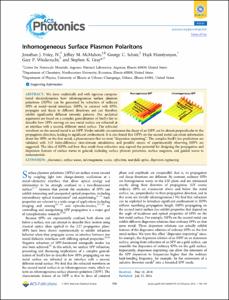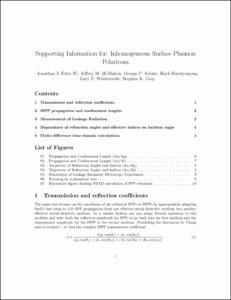Please use this identifier to cite or link to this item:
http://hdl.handle.net/20.500.12164/117Full metadata record
| DC Field | Value | Language |
|---|---|---|
| dc.contributor.author | Foley, Jonathan J., IV | - |
| dc.contributor.author | Harutyunyan, Hayk | - |
| dc.contributor.author | McMahon, Jeffrey | - |
| dc.contributor.author | Schatz, George | - |
| dc.contributor.author | Wiederrecht, Gary | - |
| dc.contributor.author | Gray, Stephen | - |
| dc.date.accessioned | 2018-09-17T17:11:33Z | - |
| dc.date.available | 2018-09-17T17:11:33Z | - |
| dc.date.issued | 2014-07-23 | - |
| dc.identifier.citation | Foley, J. J., McMahon, J. M., Schatz, G. C., Harutyunyan, H., Wiederrecht, G. P., Gray, S. K. (2014). Inhomogeneous surface plasmon polaritons. ACS Photonics, 1(8), 739--745. | en_US |
| dc.identifier.issn | 2330-4022 | - |
| dc.identifier.uri | http://doi.org/10.1021/ph500172f | - |
| dc.identifier.uri | http://hdl.handle.net/20.500.12164/117 | - |
| dc.description.abstract | We show analytically and with rigorous computa- tional electrodynamics how inhomogeneous surface plasmon polaritons (ISPPs) can be generated by refraction of ordinary SPPs at metal−metal interfaces. ISPPs, in contrast with SPPs, propagate and decay in different directions and can therefore exhibit significantly different intensity patterns. Our analytical arguments are based on a complex generalization of Snell’s law to describe how SPPs moving on one metal surface are refracted at an interface with a second, different metal surface. The refracted waveform on the second metal is an ISPP. Under suitable circumstances the decay of an ISPP can be almost perpendicular to the propagation direction, leading to significant confinement. It is also found that ISPPs on the second metal can retain information about the SPPs on the first metal, a phenomenon that we term “dispersion imprinting”. The complex Snell’s law predictions are validated with 3-D finite-difference time-domain simulations, and possible means of experimentally observing ISPPs are suggested. The idea of ISPPs and how they result from refraction may expand the potential for designing the propagation and dispersion features of surface waves in general, including surface phonon polaritons, surface magnons, and guided waves in metamaterials. | en_US |
| dc.language.iso | en_US | en_US |
| dc.publisher | American Chemical Society | en_US |
| dc.relation.ispartof | ACS Photonics | en_US |
| dc.rights | © 2014 American Chemical Society | en_US |
| dc.subject | Plasmonics | en_US |
| dc.subject | Surface Waves | en_US |
| dc.subject | Inhomogeneous Waves | en_US |
| dc.subject | Refraction | en_US |
| dc.subject | Near-field Optics | en_US |
| dc.subject | Dispersion Engineering | en_US |
| dc.subject | Chemistry | en_US |
| dc.title | Inhomogeneous Surface Plasmon Polaritons | en_US |
| dc.type | journal article | en_US |
| Appears in Collections: | Chemistry | |
Files in This Item:
| File | Description | Size | Format | |
|---|---|---|---|---|
| ISPP.pdf | Manuscript | 4.26 MB | Adobe PDF |  View/Open |
| ph500172f_si_001.pdf | Supporting Information | 1.89 MB | Adobe PDF |  View/Open |
Items in DSpace are protected by copyright, with all rights reserved, unless otherwise indicated.
